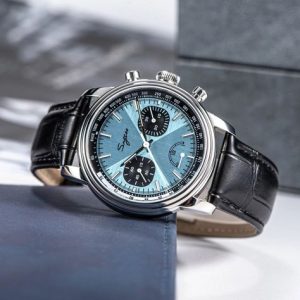Uncategorized
The Importance of Water Resistance in Watches
Water resistance is one of the most significant features of a watch, ensuring its durability and reliability under various conditions. While it may seem like a technical specification, water resistance has practical implications for daily wear, sports, and professional use. Whether you’re a swimmer, a diver, or simply someone who doesn’t want to worry about occasional splashes, understanding water resistance is essential when choosing the right watch.
At 360bestelitend.com, we explore why water resistance matters and how to select a timepiece that suits your lifestyle.
1. What Does Water Resistance Mean?

Water resistance refers to a watch’s ability to withstand moisture without compromising its internal components. However, it’s important to note that water resistance is not the same as being waterproof. No watch is entirely waterproof, but water resistance indicates the level of protection against water ingress.
- Measured in Meters or ATM:
Water resistance is typically rated in meters (e.g., 50m) or atmospheres (ATM), with 1 ATM equal to 10 meters of static water pressure. - Static vs. Dynamic Pressure:
These ratings represent theoretical conditions under static pressure. Activities like swimming or diving increase dynamic pressure, so a 30m-rated watch isn’t suitable for actual swimming despite its rating.
2. Why Water Resistance Is Important
Protects the Watch’s Internal Mechanisms
- Water can damage the delicate internal components of a watch, leading to rust, malfunction, or total failure.
- Water-resistant watches are sealed with gaskets and feature reinforced cases to keep moisture out, ensuring long-term reliability.
Enhances Durability for Everyday Wear
- Everyday activities like handwashing, light rain, or accidental splashes can expose your watch to moisture.
- Even a basic level of water resistance (e.g., 30m) can protect against these scenarios, adding convenience and peace of mind.
Essential for Specific Activities
- For swimmers, divers, and water sports enthusiasts, higher water resistance ratings are crucial.
- Professional divers rely on water-resistant watches for safety, as these timepieces often include features like depth ratings and helium escape valves.
3. Water Resistance Ratings Explained
Understanding water resistance ratings helps you choose the right watch for your needs. Below is a general guide:
- 30m (3 ATM):
- Suitable for everyday activities like handwashing or light rain.
- Not recommended for swimming or submersion.
- 50m (5 ATM):
- Can handle brief immersion, such as splashes or shallow swimming.
- Still not ideal for extensive water exposure.
- 100m (10 ATM):
- Suitable for swimming and snorkeling but not for diving.
- Offers reliable protection for active lifestyles.
- 200m (20 ATM):
- Ideal for recreational diving and water sports.
- Provides robust protection under higher water pressures.
- 300m+ (Professional Dive Watches):
- Designed for professional diving and extreme underwater conditions.
- Often includes additional features like unidirectional bezels and luminous markers.
4. Features That Enhance Water Resistance
1. Gaskets and Seals
- Rubber or silicone gaskets are used to seal the case, crown, and case back, preventing water entry.
- Regular maintenance ensures these seals remain effective over time.
2. Screw-Down Crown
- A screw-down crown locks securely into place, providing extra protection against water ingress.
- Common in dive watches, this feature is essential for activities involving high water pressure.
3. Case Material
- Stainless steel, titanium, and ceramic cases are more resistant to corrosion and wear caused by water exposure.
- These materials enhance the overall durability of the watch.
4. Sapphire Crystal
- Sapphire crystal is often used for watch faces due to its scratch resistance and ability to withstand pressure changes.
5. Helium Escape Valve
- Found in professional dive watches, this feature releases helium gas that may build up during deep dives, preventing the crystal from popping off.
5. Water Resistance Maintenance
Proper care ensures that your water-resistant watch remains effective over time:
- Avoid Hot Water: Exposure to hot water (e.g., showers, saunas) can damage seals and compromise water resistance.
- Check the Seals Regularly: Have your watch’s gaskets and seals checked every few years by a professional.
- Avoid Pressing Buttons Underwater: Unless the watch is specifically designed for it, pressing buttons or operating the crown underwater can allow water to enter.
- Rinse After Saltwater Exposure: Saltwater can corrode components, so rinse your watch with freshwater after swimming in the ocean.
6. Choosing the Right Water Resistance for Your Lifestyle
For Daily Wear
- A watch with 30m or 50m water resistance is sufficient for light exposure to moisture.
For Active Lifestyles
- Opt for a watch with at least 100m water resistance if you enjoy swimming or light water activities.
For Diving Enthusiasts
- Choose a dive watch with a 200m+ rating, featuring specialized features like luminous markers and unidirectional bezels.
For Extreme Activities
- Professional-grade dive watches with 300m+ ratings and helium escape valves are essential for technical or deep-sea diving.
7. The Role of Water Resistance in Watch Design
Water-resistant watches are not just practical—they’re also stylish. Many iconic watch designs, like the Rolex Submariner and Omega Seamaster, are celebrated for their water resistance and robust aesthetics.
- Sporty Appeal: Water-resistant watches often feature bold designs, making them versatile for both active and casual wear.
- Luxury Durability: High-end brands incorporate water resistance seamlessly into elegant designs, ensuring their watches are both functional and fashionable.
8. Popular Water-Resistant Watch Brands

Several brands are renowned for their expertise in water-resistant watches:
- Rolex Submariner: A classic dive watch with a 300m water resistance rating, perfect for professionals and enthusiasts.
- Omega Seamaster: Known for its association with James Bond, offering water resistance up to 300m.
- Seiko Prospex: Affordable and reliable dive watches with ratings from 100m to 200m+.
- Casio G-Shock: Rugged, shock-resistant watches with excellent water resistance for outdoor adventures.
- Citizen Promaster: Eco-Drive watches that combine solar power with impressive water resistance.
Conclusion
Water resistance is a critical feature in any watch, offering protection, durability, and versatility for various lifestyles. Whether you’re looking for a daily wear watch, a sporty companion, or a professional-grade dive watch, understanding water resistance helps you make an informed decision.
At 360bestelitend.com, we offer a wide range of water-resistant watches to suit every need. Explore our collection today and find the perfect timepiece to match your lifestyle—rain, shine, or underwater adventure!

